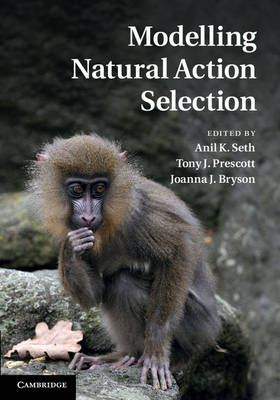
Modelling Natural Action Selection
Cambridge University Press (Verlag)
978-1-107-00049-0 (ISBN)
Action selection is the task of doing the right thing at the right time. It requires the assessment of available alternatives, executing those most appropriate, and resolving conflicts among competing goals and possibilities. Using advanced computational modelling, this book explores cutting-edge research into action selection in nature from a wide range of disciplines, from neuroscience to behavioural ecology, and even political science. It delivers new insights into both detailed and systems-level attributes of natural intelligence and demonstrates advances in methodological practice. Contributions from leading researchers cover issues including whether biological action selection is optimal, neural substrates for action selection in the vertebrate brain, perceptual selection in decision making, and interactions between group and individual action selection. This first integrated review of action selection in nature contains a balance of review and original research material, consolidating current knowledge into a valuable reference for researchers while illustrating potential paths for future studies.
Anil K. Seth is a Reader in the School of Informatics at the University of Sussex, an EPSRC Leadership Fellow and Co-Director of the Sackler Centre for Consciousness Science. His research crosses the fields of computational neuroscience, consciousness science and neurorobotics. In addition to contributing new insights into the mechanisms of action selection, he has developed new ways to link brain activity to conscious experience and he is an authority on the statistical analysis of causality. Tony Prescott is a Professor of Cognitive Neuroscience at the University of Sheffield where he teaches courses on computational neuroscience and biomimetic robotics. His research lies within the biological and brain sciences and concerns understanding the evolution, development and function of natural intelligence. He is particularly well known for his work on modelling the neural substrates for action selection and building robot models of animal and human behaviour. Joanna J. Bryson is a Reader in the Department of Computer Science at the University of Bath. She conducts interdisciplinary research on the origins, structure and construction of human and animal-like intelligence and is involved in topics ranging from the evolution of altruistic communication to the ethical role of robots in our society. She is best known for her work in systems AI and the design of action selection and, more recently, for her work on the evolution of human social structure and reliance on cultural intelligence.
Foreword Peter M. Todd; 1. General introduction Anil K. Seth, Joanna J. Bryson and Tony J. Prescott; Part I. Rational and Optimal Decision Making: 2. Introduction to Part I: rational and optimal decision making Anil K. Seth, Tony J. Prescott and Joanna J. Bryson; 3. Do we expect natural selection to produce rational behaviour? Alasdair I. Houston, John M. McNamara and Mark D. Steer; 4. Optimised agent-based modelling of action selection Anil K. Seth; 5. Compromise strategies for action selection Frederick L. Crabbe; 6. Extending a biologically inspired model of choice: multi-alternatives, nonlinearity and value based multidimensional choice Rafal Bogacz, Marius Usher, Jiaxiang Zhang and James L. McClelland; 7. Bayesian approaches to modelling action selection Max Berniker, Kunlin Wei and Konrad Kording; 8. Post-retrieval inhibition in sequential memory search Eddy J. Davelaar; Part II. Computational Neuroscience Models: 9. Introduction to Part II: computational neuroscience models Tony J. Prescott, Joanna J. Bryson and Anil K. Seth; 10. Action selection and refinement in subcortical loops through basal ganglia and cerebellum James C. Houk; 11. Cortical mechanisms of action selection: the affordance competition hypothesis Paul Cisek; 12. Toward an executive without a homunculus: computational models of the prefrontal/basal ganglia system Thomas E. Hazy, Michael J. Frank and Randall C. O'Reilly; 13. Hierarchically organized behaviour and its neural foundations Matthew M. Botvinick, Yael Niv and Andrew C. Barto; 14. The medial reticular formation: a brainstem substrate for simple action selection? Mark D. Humphries, Kevin N. Gurney and Tony J. Prescott; 15. Understanding decision making deficits in neurological conditions: insights from models of natural action selection Michael J. Frank, Anouk Scheres and Scott J. Sherman; 16. Biologically constrained action selection improves cognitive control in a model of the Stroop task Tom Stafford and Kevin N. Gurney; 17. Mechanisms of choice in the primate brain: a quick look at positive feedback Jonathan M. Chambers, Kevin N. Gurney, Mark D. Humphries and Tony J. Prescott; Part III. Action Selection in Social Contexts: 18. Introduction to Part III: action selection in social contexts Joanna J. Bryson, Tony J. Prescott and Anil K. Seth; 19. Agent-based models as scientific methodology: a case study analyzing the DomWorld theory of primate social structure and female dominance Joanna J. Bryson, Yasushi Ando and Hagen Lehmann; 20. An agent-based model of group decision making in baboons Russell A. Hill, Brian S. Logan, William I. Sellers and Julian Zappala; 21. Endogenous birth and death of political parties in dynamic party competition Michael Laver, Ernest Sergenti and Michel Schilperoord; 22. On optimal decision-making in brains and social insect colonies James A. R. Marshall, Rafal Bogacz, Anna Dornhaus, Robert Planqué, Tim Kovacs and Nigel R. Franks; 23. State-dependent foraging rules for social animals in selfish herds Sean A. Rands, Richard A. Pettifor, J. Marcus Rowcliffe and Guy Cowlishaw; Index.
| Erscheint lt. Verlag | 10.11.2011 |
|---|---|
| Zusatzinfo | 9 Plates, black and white; 18 Halftones, unspecified; 108 Line drawings, unspecified |
| Verlagsort | Cambridge |
| Sprache | englisch |
| Maße | 183 x 254 mm |
| Gewicht | 1300 g |
| Themenwelt | Naturwissenschaften ► Biologie ► Evolution |
| Naturwissenschaften ► Biologie ► Zoologie | |
| ISBN-10 | 1-107-00049-1 / 1107000491 |
| ISBN-13 | 978-1-107-00049-0 / 9781107000490 |
| Zustand | Neuware |
| Haben Sie eine Frage zum Produkt? |
aus dem Bereich


